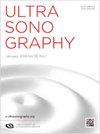Re: Subdivision of intermediate suspicion, the 2021 K-TIRADS, and category III, indeterminate cytology, the 2017 TBSRTC, 2nd edition, in thyroidology: let bygones be bygones?
IF 2.4
3区 医学
Q2 RADIOLOGY, NUCLEAR MEDICINE & MEDICAL IMAGING
引用次数: 0
Abstract
How to cite this article: Kim H, Hahn SY, Shin JH, Kim MK. Re: Subdivision of intermediate suspicion, the 2021 K-TIRADS, and category I I I , indeterminate cytology, the 2017 TBSRTC, 2nd edition, in thyroidology: let bygones be bygones?. Ultrasonography 2023 Sep 11 [Epub]. https://doi.org/10.14366/usg.23172 We were greatly interested to read the letter to the editor from Sengul and Sengul, which pertains to our recent paper on the subcategorization of intermediate suspicion thyroid nodules, based on suspicious ultrasonographic (US) findings [1]. We appreciate the interest that Sengul and Sengul have shown in our paper and value their insightful comments on the complex issue of subdivision. The main focus of their comment and question seems to be about the echogenicity of the included thyroid nodules. We agree that our explanation of the nodules' echogenicity may not have been sufficiently clear. However, our initial study population was restricted to thyroid nodules in the Korean Thyroid Imaging Reporting and Data System (K-TIRADS) category 4 (intermediate suspicion) [1,2]. Therefore, from the outset, our study did not include any partially cystic or isoechoic/ hyperechoic nodules without any of the three suspicious US findings (punctate echogenic foci, nonparallel orientation, or irregular margins). These were classified as K-TIRADS category 3 (low suspicion). Similarly, we did not include solid hypoechoic nodules with any of the three suspicious US findings, as these were initially classified as K-TIRADS category 5, as Sengul and Sengul correctly noted. The K-TIRADS category 4 (intermediate suspicion) includes three types of nodules: (1) solid hypoechoic nodules without any of the three suspicious US findings, (2) entirely calcified nodules, and (3) partially cystic or isoechoic/hyperechoic nodules with any of the three suspicious US findings. Therefore, in our study, the "nodules without suspicious findings" group included solid hypoechoic nodules without any of the three suspicious US findings and entirely calcified nodules which do not allow for the assessment of nodule echogenicity. The "nodules with suspicious findings" group only included partially cystic or isoechoic/hyperechoic nodules with any of the three suspicious US findings. Consequently, the conclusions of our study remain unchanged. We agree with Sengul and Sengul regarding the importance of focusing on the subdivision of the intermediate or indeterminate category, whether from a pathological or radiological perspective. We extend our sincere gratitude to the authors for their valuable contribution to the discussion.回复:甲状腺学中中间怀疑的细分,2021 K-TIRADS,和第三类,不确定细胞学,2017年TBSRTC,第2版:让过去的过去吧?
本文章由计算机程序翻译,如有差异,请以英文原文为准。
求助全文
约1分钟内获得全文
求助全文
来源期刊

Ultrasonography
Medicine-Radiology, Nuclear Medicine and Imaging
CiteScore
5.10
自引率
6.50%
发文量
78
审稿时长
15 weeks
期刊介绍:
Ultrasonography, the official English-language journal of the Korean Society of Ultrasound in Medicine (KSUM), is an international peer-reviewed academic journal dedicated to practice, research, technology, and education dealing with medical ultrasound. It is renamed from the Journal of Korean Society of Ultrasound in Medicine in January 2014, and published four times per year: January 1, April 1, July 1, and October 1. Original articles, technical notes, topical reviews, perspectives, pictorial essays, and timely editorial materials are published in Ultrasonography covering state-of-the-art content.
Ultrasonography aims to provide updated information on new diagnostic concepts and technical developments, including experimental animal studies using new equipment in addition to well-designed reviews of contemporary issues in patient care. Along with running KSUM Open, the annual international congress of KSUM, Ultrasonography also serves as a medium for cooperation among physicians and specialists from around the world who are focusing on various ultrasound technology and disease problems and relevant basic science.
 求助内容:
求助内容: 应助结果提醒方式:
应助结果提醒方式:


